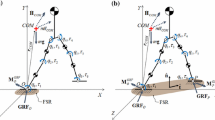Abstract
The nonholonomic motion planning of a free-falling cat is investigated. Nonholonomicity arises in a free-falling cat subject to nonintegrable angle velocity constraints or nonintegrable conservation laws. When the total angular momentum is zero, the motion equation of a free-falling cat is established based on the model of two symmetric rigid bodies and conservation of angular momentum. The control of system can be converted to the problem of nonholonomic motion planning for a free-falling cat. Based on Ritz approximation theory, the Gauss-Newton method for motion planning by a falling cat is proposed. The effectiveness of the numerical algorithm is demonstrated through simulation on model of a free-falling cat.
Similar content being viewed by others
References
Jia Shuhui. About a free-falling cat[M]. Beijing: Higher Education Press, 1990 (in Chinese).
McDonald D A. How dose a falling cat turn over[J]. Amer J Physiol, 1955, 129:34–35.
Loitsyansky A I. Theoretical mechanics[M]. Moscow: Saint Petersburg, 1953 (in Russian).
Kane T R, Scher M P. A dynamical explanation of the falling cat phenomenon[J]. Int J Solids Structures, 1969, 5(5):663–670.
Liu Yanzhu. On the turning motion of a free-falling cat[J]. Acta Mechanica Sinica, 1982, 14(4):388–393 (in Chinese).
Brockett R W, Dai L. Nonholonomic kinematics and the role of elliptic functions in constructive controllability[C]. In: Li Z, Canny J F (eds). Nonholonomic Motion Planning, Boston: Kluwer, 1993, 1–22.
Murray R M, Sastry S S. Nonholonomic motion planning: steering using sinusoids[J]. IEEE Transactions on Automatic Control, 1993, 38(5):700–716.
Reyhanoglu M, Schaft A, McClamroch N, Komlanovsky I. Dynamics and control of a class of underactuated mechanical systems[J]. IEEE Transactions on Automatics Control, 1999, 44(9):1663–1671.
Leonard N E, Krishnaprasad P S. Motion control of drift-free, left-invariant systems on lie groups[J]. IEEE Transactions on Automatics Control, 1995, 40(9):1539–1554.
Fernandes C, Gurvits L, Li Z. Near-optimal nonholonomic motion planning for a system of coupled rigid bodies[J]. IEEE Transaction Automation Control, 1995, 39(3):450–464.
Liu Yanzhu, Hong Jiazheng, Yang Haixin. Dynamics of multibody systems[M]. Beijing: Higher Education Press, 1990 (in Chinese).
Courant R, Hilbert D. Methods of mathematical physics[M]. Vol. I, New York: Wiley, 1955.
Joshi M C, Moudgalya K M. Optimization-theory and practice[M]. Harrow U K: Alpha Science International Ltd, 2004.
Author information
Authors and Affiliations
Corresponding author
Additional information
(Contributed by CHEN Li-qun)
Project supported by the National Natural Science Foundation of China (No.10372014) and the Natural Science Foundation of Beijing (No.1072008)
Rights and permissions
About this article
Cite this article
Ge, Xs., Chen, Lq. Optimal control of nonholonomic motion planning for a free-falling cat. Appl Math Mech 28, 601–607 (2007). https://doi.org/10.1007/s10483-007-0505-z
Received:
Revised:
Issue Date:
DOI: https://doi.org/10.1007/s10483-007-0505-z




